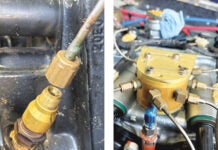Im sure that most VFR aviators have heard over and over again that adding an instrument rating will make them a better pilot. It’s not that adding the rating is going to let them launch into ay kind of weather, and make their flying as reliable as buying an airline ticket—it won’t (unless they can afford a true all-weather aircraft, and in that case, they can probably afford to hire a full-time pilot as well). But adding the rating gives a person a totally different framework for their flying—a rigorous structure that centers on being procedural, doing things the same way every time, and sharpening up their precision in all of their flying. Sure, you can do all of those things as a VFR pilot, and many do—but getting the instrument ticket forces the process.
I am finding that as I prepare for my A&P oral and practical tests, that the same thing is occurring in my building and maintaining mind. Oh, I have always been precise and demanding in how I build and maintain my aircraft, but thinking about it within the context of A&P procedures and record-keeping is making me tighten up my game even more. I am thinking more in terms of checklists and precision in logbook entries, for starters. Helping others in my class (all the fine young folks getting their FAA licenses based on their military service as turbine aircraft maintainers) is forcing me to make sure that I not only speak about correct skills and techniques, but about the paperwork and record-keeping as well.
Is the A&P the instrument ticket of the building an maintaining world? I think that to some extent, yes—it is. We always need to remember, of course, that the typical experienced builder will have far more time in fabrication, assembly and construction than almost any A&P. The mechanic’s license is about maintenance and repair, not building from the ground up. But what I have found in the homebuilt world today is that many builders are excellent at metal, fabric, or fiberglass construction and repair, but much less confident about routine engine and systems maintenance, because those are elements that they have bought and installed, rather than constructed. Is one better than the other? I think that is the wrong question, for in truth, the builder and mechanic complement each other.
Regardless—getting some formal training is always beneficial, whether it is in the air or on the ground, because we should always keeping learning. Whether you decide to make the leap to an A&P certificate after a lifetime of working on airplanes, or simply attend a weekend workshop on aircraft wiring—learning is good, because it opens our minds to the fact that nope, we will never know it all.














